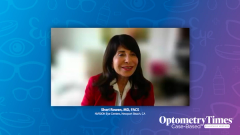
Patient Case No. 1: Managing Dry Eye in a Patient Before Cataract Surgery
An expert presents a case of dry eye in a patient who has undergone several eye surgeries and now requires cataract surgery.
Sheri Rowen, MD, FACS: Hello, I’m Dr Sherri Rowen. I’m a cataract and refractive surgeon in Newport Beach, California. I am very excited to share 2 interesting cases that we recently presented at an Ophthalmology TimesÒ roundtable event. The first one [involves] a 62-year-old [woman]. These are my patients. She was status post myopic LASIK [laser in situ keratomileusis]. She also had PRK [photorefractive keratectomy surgery] to touch her up many years ago, and she subsequently developed ectasia or keratoconus. It’s hard to know, but they are the same phenomenon in this situation, and she underwent crosslinking. She has worn rigid gas-permeable lenses. She can’t see very well otherwise without those lenses. And she developed extreme dry eye. We’ll show here her upper lids. And you can see her meibomian glands have significant dropout. You can see the threads that were left behind. And there are still some that are functioning on the right side of the screen. But you can see how interesting the dropout looks. And when you look at the lower lids, she still has architecture of the glands. But if you look at the bottom of the glands, it’s very dark. It’s more lucent. And these glands were not expressing meibum at all when we started her treatments.
So she had corneal staining. She was red. She was really uncomfortable and really had tried many things when she came in, and really nothing worked. She had gone through artificial tears. We had tried all the cyclosporine [options], [such] as Restasis and Cequa. We did lifitegrast, or Xiidra, and these all burned her eye, and they were really intolerable. We did BlephEx to clean off the surface of her lid margins because they were also keratinized. We did LipiFlow for her significant meibomian gland dysfunction, and we did see some meibum that started coming out a little bit from those blocked glands afterward, but they were completely blocked before that. We placed punctal plugs, used warm compresses, and enrolled her in the NOV03, which became Meibo, which is available now. That’s a new antievaporative drug, and it worked very well on her. So she was in that study. We knew that she had certainly had evaporative disease when we first examined her. We got her pretty comfortable; she was able to wear soft contact lenses. She saw reasonably well with these for a while and then developed cataracts. So now, knowing her history, I felt her corneas were too dry to ever do LASIK on her again as a touch-up. The plan was—and we were lucky for this because we had finally gotten access to the light-adjustable lenses [and] felt that if we could put the light of the adjustable lenses and we could adjust the power in her lenses for her to see and hopefully get her out of contacts, which did happen. She is out of contact lenses. She’s markedly improved. She sees very well and without additional help, and she rarely has to put on glasses. We basically were able to use one eye for distance and one eye for a mini monovision for her reading. And at the end to control her dry eye, I added varenicline, which is Tyrvaya, after the study was over, which helped her symptoms. This was well tolerated and is still well tolerated because it’s not going in her eyes. Her staining has improved, and she will be back on Meibo when that is available for her in 2 weeks.
Transcript is AI-generated and edited for clarity and readability.
Newsletter
Want more insights like this? Subscribe to Optometry Times and get clinical pearls and practice tips delivered straight to your inbox.














































.png)


